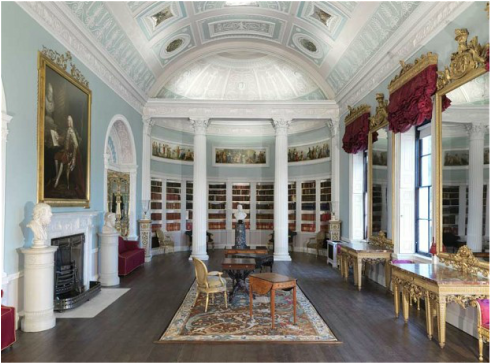 Kenwood House Library Kenwood House Library Dido Belle was born circa the early 1760s, although no definitive birth date or year has been recorded with absolute certainty. Her birth origins are widely known, however, in which Belle was reported as being born into slavery in the West Indies – an area of the Caribbean islands known as modern Cuba, Jamaica, Haiti, the Dominican Republic, and Puerto Rico today. It is said that her mother, an African slave by the name of Maria Belle, was probably taken by force rather than fondness by her father – a young, Naval officer named John Lindsay – during the Seven Years’ War, where European colonials and explorers were still discovering the Americas, capturing rival ships, and making off with the region’s goods, from sugar and coffee to human cargo. Belle’s father eventually returned to England, taking his young mulatto daughter, Dido, along with him. Whether the shame was too great for him to bear, or he did not feel adequate enough to raise a child on his own, the Navy captain and wealthy aristocrat asked his extended, childless relatives to take care of Dido on his behalf. Lindsay’s uncle, William Murray, the first Earl of Mansfield, accepted, and along with his wife, Elizabeth, raised Dido in their North London home at Kenwood House – a lavish, extravagant estate for its time, with vast, landscaped gardens and palatial grandeur. They baptized and renamed the small child to Dido Elizabeth Belle. While colonial laws of the time dictate that Belle was a slave due to her mother’s lineage, the blooming aristocrat was privileged by name, and now, by upbringing, as her uncle was also Lord Chief Justice, the most powerful position of its nature in the country at the time. Belle was well-educated, well-dressed, and well-fed as a member of her new family – but her position, both within the Murrays’ household and London society at large, was often blurred due to her illegitimacy and obvious darker skin color and frizzy, curly hair. In fact, Belle was too well-bred for a servant, yet too different and frowned upon in the eyes of London’s high society. Furthermore, the Earl and Countess of Mansfield were also raising another one of their nieces, Lady Elizabeth Murray, an orphan of Belle’s age for whom many historians have suggested that she was intended to serve as a playmate or personal attendant. While little is known of Belle’s adult life, the diaries of American governor and Loyalist Thomas Hutchinson who lived in London at the time, paint a picture that described Belle transcribing many, if not most, of her Chief Justice uncle’s dictations and legal discourses on various slavery cases. She was said to have influenced him, whether directly or indirectly, in his final decisions – decisions that were crucial in the eventual abolishment of the slave trade in England. In 2013, a film by her namesake of Belle profiled the story of the mysterious mixed-race noblewoman. While the movie has likely exaggerated her involvements in her uncle’s legal affairs, historical records show that he did leave her, upon his death, a life inheritance along with words that she was a free woman. Five months later, Belle married John Davinier – depicted in the film as a non-wealthy yet passionate law student, but a steward and reverend’s son in real life – with whom she had three children. Belle passed of natural causes in her early 40s, with simply a painting of her and her cousin, Lady Elizabeth Murray, previously displayed at Scone Palace in the UK to fuel interest into her fascinating, yet unknowable story. By Kim Tran
0 Comments
Your comment will be posted after it is approved.
Leave a Reply. |
Archives
July 2017
Categories
All
|
 RSS Feed
RSS Feed